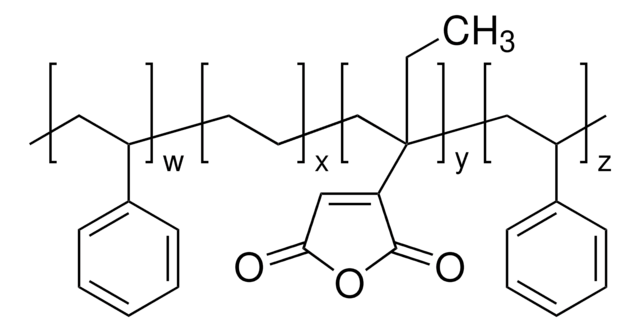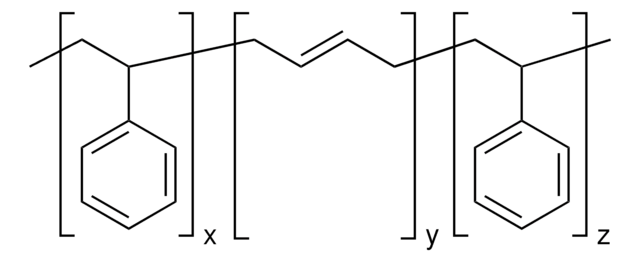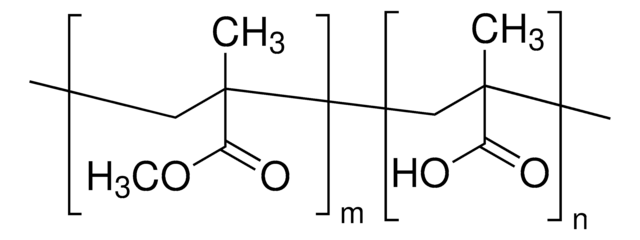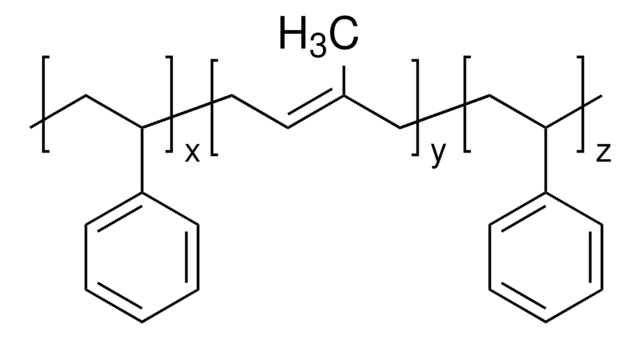추천 제품
양식
solid
Quality Level
분자량
Mn 27,000-31,000 (polystyrene)
Mn 31,000-37,000 (total)
Mn 4,000-6,000 (poly(acrylic acid))
mp
258-263 °C
PDI
≤1.3
유사한 제품을 찾으십니까? 방문 제품 비교 안내
애플리케이션
Polystyrene-block-polyacrylic acid is a diblock copolymer used for making polymeric vesicles (polymersomes) and other encapsulation applications.1-9 This PS-block-PAA copolymer is 15 wt. % AA; and should form vesicles in water in the 100 nm range. The polystyrene degree of polymerization (DP) is 275 and the polyacrylic acid DP is 50.
법적 정보
Sold for research purposes only. Not for use in humans. Before opening or using this product, please read the following terms and conditions. Use of this product shall constitute acknowledgement and acceptance of these terms and conditions: Use of this product may be covered by one or more of the following US patents and corresponding claims outside the US: 7,714,075; 7,250,479; 7,666,962; 6,642,318; 6,747,111, and pending applications (W2010/8356). For details contact Aldrich Chemical Company, Inc.
신호어
Warning
유해 및 위험 성명서
Hazard Classifications
Eye Irrit. 2 - Skin Irrit. 2 - STOT SE 3
표적 기관
Respiratory system
Storage Class Code
11 - Combustible Solids
WGK
WGK 3
Flash Point (°F)
Not applicable
Flash Point (°C)
Not applicable
가장 최신 버전 중 하나를 선택하세요:
Block Length Dependence of Morphological Phase Diagrams of theTernary System of PS-b-PAA/Dioxane/H2O
Hongwei Shen and Adi Eisenberg
Macromolecules, 33(7), 2561-2561 (2000)
Multiple Morphologies and Characteristics of ?Crew-Cut? Micelle-like Aggregates of Polystyrene-b-poly(acrylic acid) Diblock Copolymers in Aqueous Solutions
Lifeng Zhang and Adi Eisenberg
Journal of the American Chemical Society, 118, 3168-3181 (1996)
Amphiphilic core?shell nanospheres obtained by intramicellar shell crosslinking of polymer micelles with poly(ethylene oxide) linkers
Haiyong Huang,
Chemical Communications (Cambridge, England), 13, 1415-1415 (1998)
Effect of Poly(acrylic acid) Block Length Distribution on Polystyrene-b-Poly(acrylic acid) Aggregates in Solution. 1. Vesicles
Owen Terreau,
Langmuir, 19, 5601-5607 (2003)
Preparation of orthogonally-functionalized core Click cross-linked nanoparticles
Rachel K. O?Reilly,
New. J. Chem., 31, 718-724 (2007)
문서
Reversible addition–fragmentation chain transfer (RAFT) polymerization is rapidly moving to the forefront in construction of drug and gene delivery vehicles.
The development of drugs that target specific locations within the human body remains one of the greatest challenges in biomedicine today.
Over the past two decades, the rapid advance of controlled living polymerization (CLP) techniques.
자사의 과학자팀은 생명 과학, 재료 과학, 화학 합성, 크로마토그래피, 분석 및 기타 많은 영역을 포함한 모든 과학 분야에 경험이 있습니다..
고객지원팀으로 연락바랍니다.







